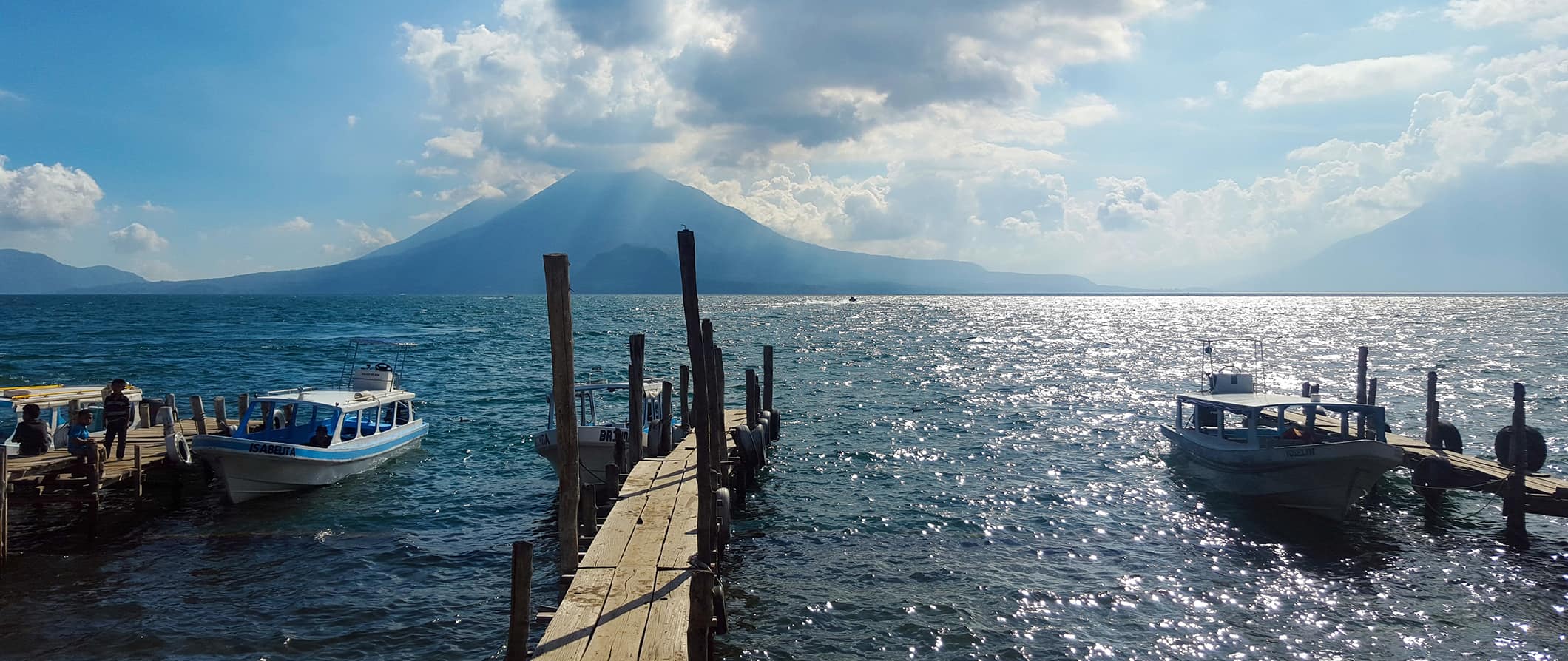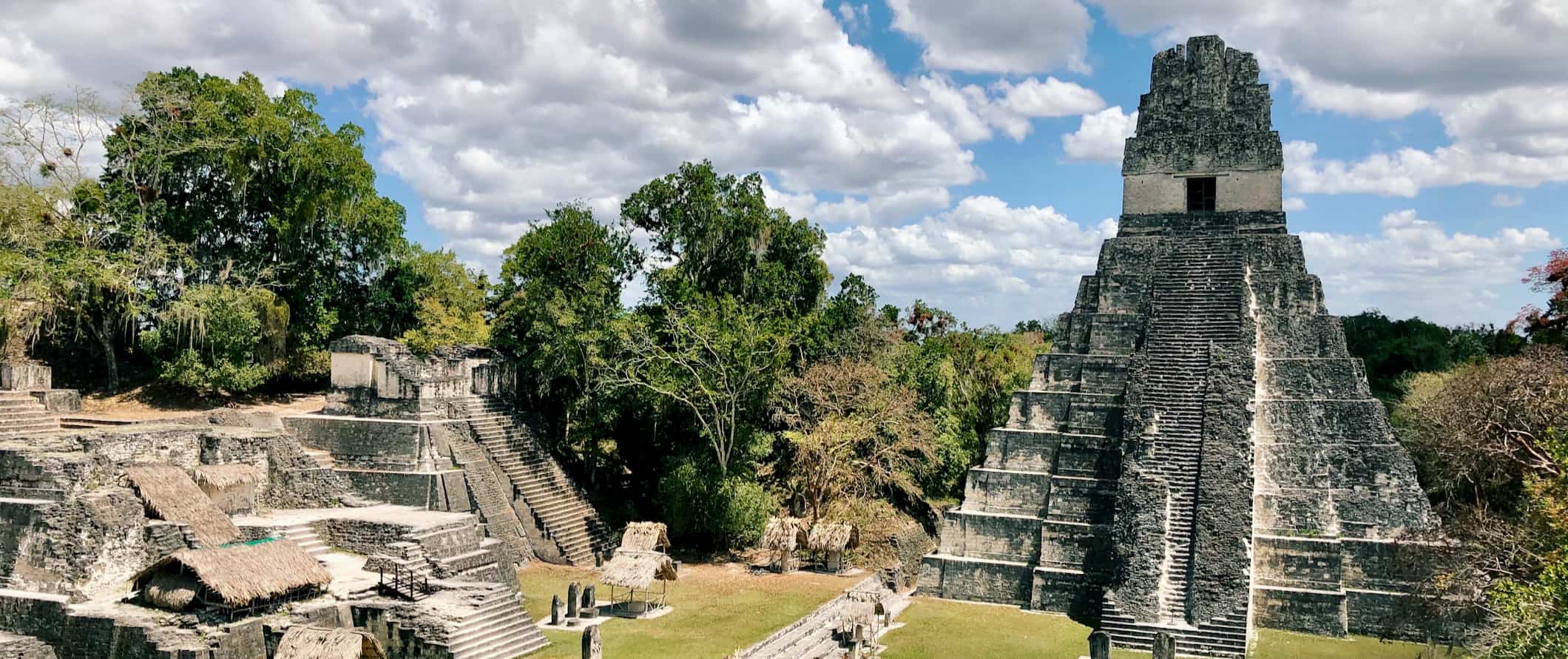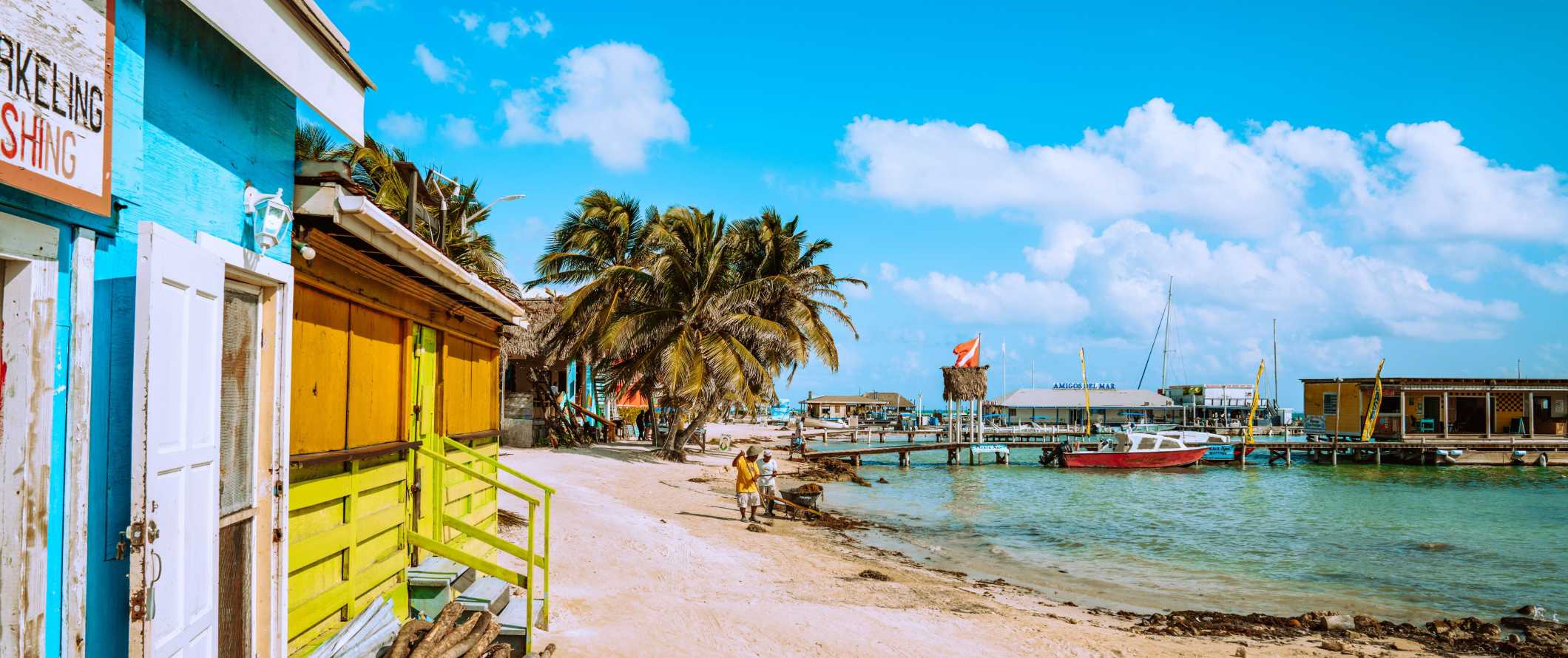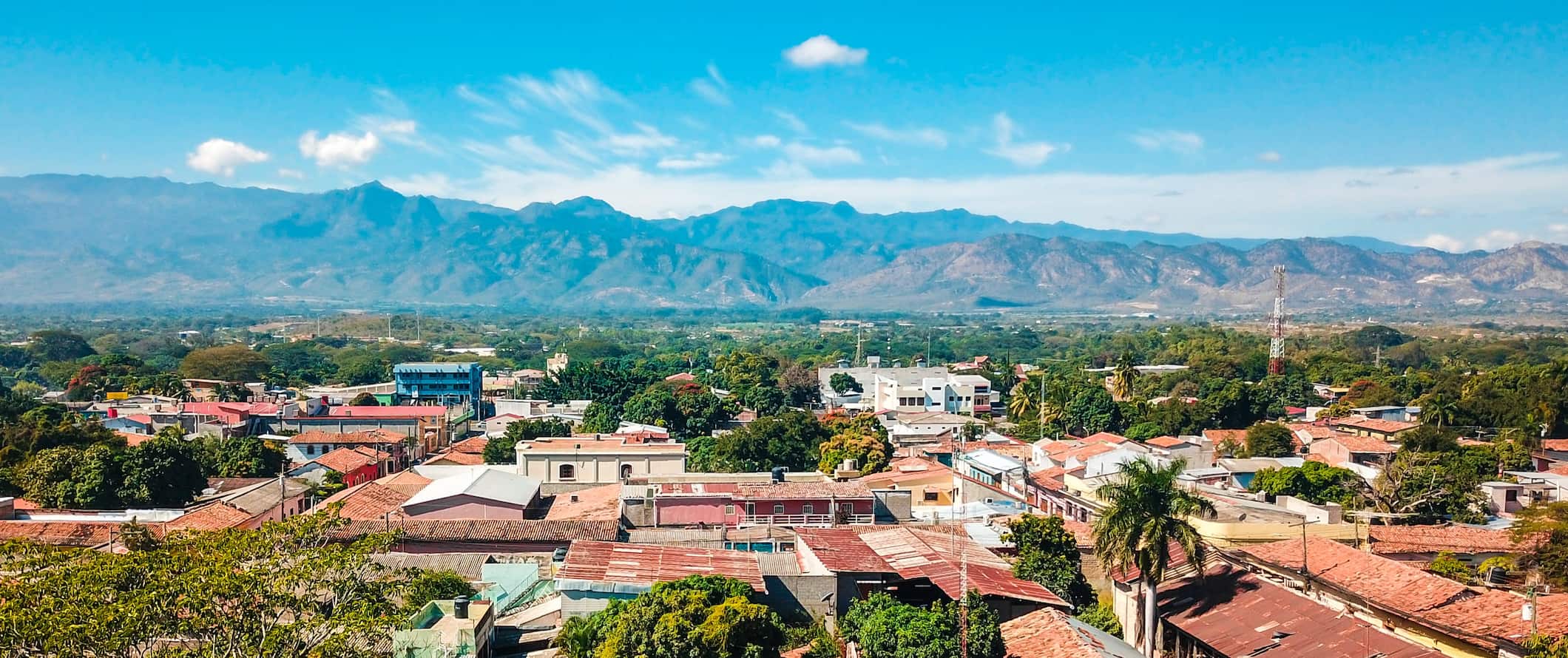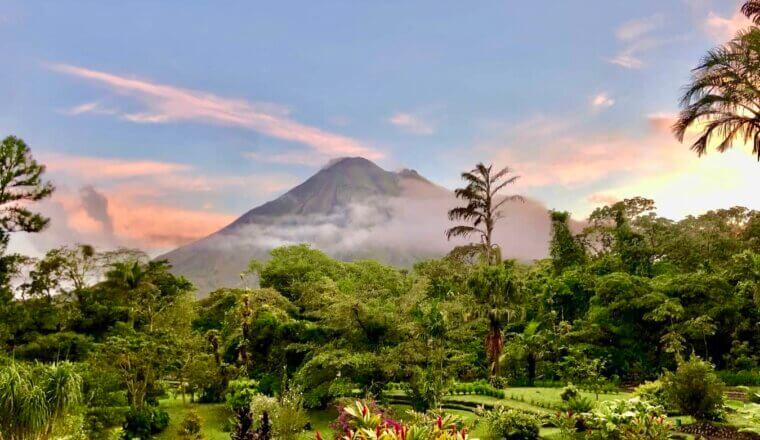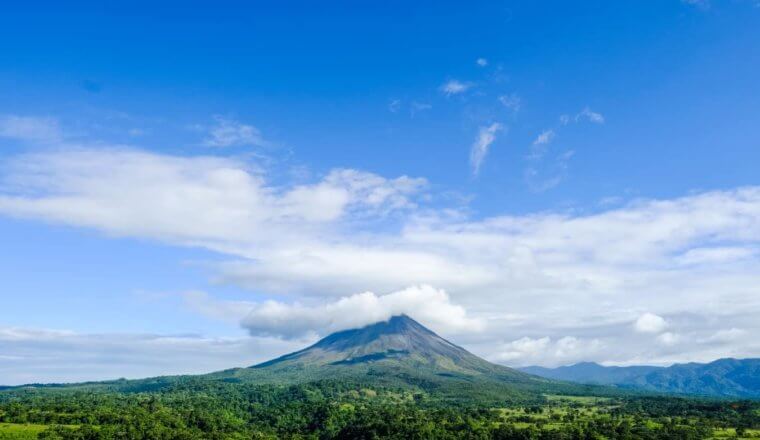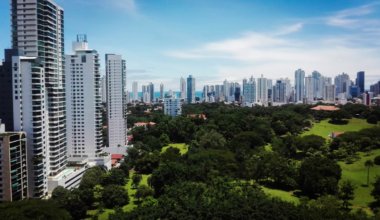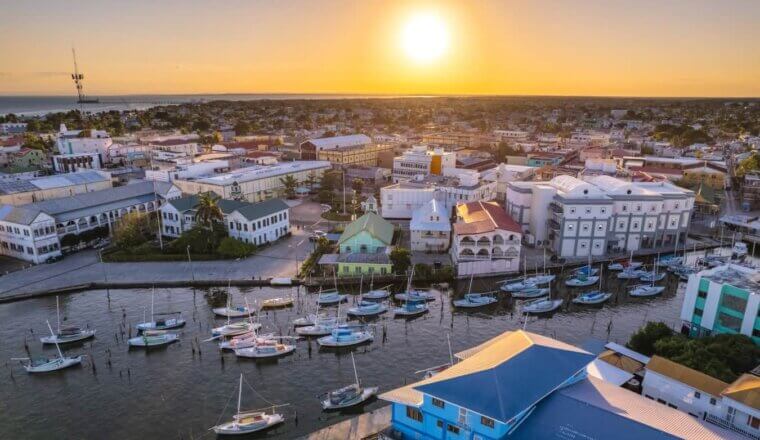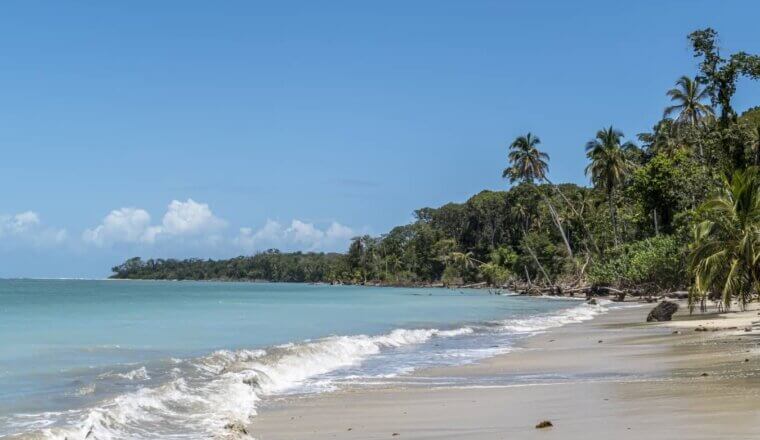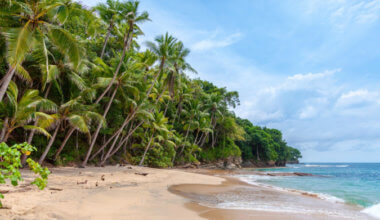Surrounded by the Pacific and Atlantic Oceans, the slender land bridge of Central America runs from Mexico to South America and is made up of seven countries: Guatemala, Belize, El Salvador, Honduras, Nicaragua, Costa Rica, and Panama.
Political and civil unrest in the 1980s kept most tourists away for decades (people never forget bad news), but now the area is becoming hotspot for travelers, surfers, luxury travelers, and even retirees.
Why?
Because Central America is beautiful, filled with history, affordable, and much safer than it used to be.
While there are still regions where you need to be vigilant, people have realized that it’s not the place the media makes it out to be. The region’s rainforests are filled with unexplored Mayan ruins and wildlife, its beaches are great for surfing, its reefs offer world-class diving, there’s a huge variety of flora and fauna here, and the cheap accommodation, food, and transport throughout the region make it a budget traveler’s dream.
I’m glad the collective consciousness is shifting and people are finally recognizing how amazing this area. I began my nomadic life traveling around Central America and whenever I return, I fall in love even more with the friendliness of the people, the tasty food, the weather, the history, and the beauty.
This travel guide to Central America will give you all the tips to help you plan your trip, stay safe, and save money in this underrated region of the world.
Table of Contents
Click Here for Country Guides
Top 5 Things to See and Do in Central America
1. Explore the volcanoes
This region is rich in volcanoes — both active and inactive. You can hike, take a horse up, and even roast marshmallows at Pacaya (Guatemala), known for frequently erupting in ash clouds. Poás (Costa Rica) is famous for its green volcano crater lake, Arenal has hiking trails, geothermal springs, a gorgeous rainforest area with waterfalls, ziplining tours and a plethora of wildlife. Masaya in Nicaragua is well known for its spectacular crater lava lake that you can visit at night to truly see the bubbling lava (coined ‘La Boca de Infierno’ (or ‘Mouth of Hell’). For adventure seekers, don’t miss trying some adrenaline-inducing sandboarding down Cerro Negro volcano in Nicaragua.
2. See Mayan ruins
Central America has many ruin sites. Tikal, in Guatemala, is an enormous national park and a UNESCO World Heritage Site with centuries of Mayan history and archeology covered in lush vegetation and rare tropical wildlife. Copán in Honduras dates back to the 5th century and boasts intricate stelae, tunnels, a hieroglyphic stairway, and lush tropical vegetation filled with monkeys, sloths, parrots, and macaws. Meanwhile, Xunantunich is one of Belize’s most impressive and easily accessible Maya sites known for its scenic location in the middle of the jungle. Last but not least, San Andrés archeological site in El Salvador is the largest pre-hispanic ruins site in the country and includes pyramids and ancient plazas. The intricate wall carvings, imposing pyramids, and crumbling columns should not be missed. Prices vary but expect to spend around $20 USD for admission.
3. Relax on Caye Caulker, Belize
This little island is incredibly popular with backpackers. It’s less expensive than some of the larger islands in the country and has a relaxed atmosphere to it. There is something here for everyone and there is way more to do here than just lay out on the exquisite beaches (although this is definitely a place you could chill for a few days). However, it’s also a spectacular place to see the delicate ecosystems of Caye Caulker Forest Reserve, which is filled with rare tropical plants and marine life. Caye Caulker is also a great place to snorkel with nurse sharks, dive the Belize Barrier Reef or the Great Blue Hole, swim with gentle manatees, or just kayak around “The Split” in paradise. July is a great time to go because of their famous lobster festival, offering tasty lobster as well as lively beach parties.
4. See the Panama Canal
First opened in 1914, the Panama Canal is an 80-kilometer (50-mile) marvel of human labor and engineering. 13,000-14,000 ships cross between the Pacific Ocean and the Caribbean every single year thanks to the canal (nearly a million boats have crossed since its construction). The canal raises ships an impressive 27 meters (85 feet) using a complex lock system, so it takes 8-10 hours for each boat to cross. The Canal relies on three sets of locks: Miraflores and Pedro Miguel Locks on the Pacific side and Gatun Locks on the Caribbean side. The most common place to see the canal is at Miraflores Locks in Panama. Admission is $20 USD.
5. Trek through the rainforests
Much of Central America is covered in lush and humid rainforests. A popular way to see these is to take a canopy tour, where you’ll be suspended on a zip-line and glide over the tops of the trees. The rainforests are filled with howler monkeys, jaguars, lizards, tropical birds, and so much more. Check out Costa Rica’s Volcán Arenal or La Fortuna Zip lines for breathtaking scenic views. Or Guatemala’s Atitlán canopy tours, where you can zip right over the stunning blue lake below. Honduras’s remote paradise Roatán Island offers incredible zip line views of its perfect crystal coast before sunning on the beach too. Expect to pay $40-65 USD.
Other Things to See and Do in Central America
1. Head to Antigua
Considered one of the best-preserved colonial cities, Antigua (in Guatemala) is a major travel hotspot for backpackers. Wander around the Spanish-style cobbled streets and visit the ruins of San Francisco Church. Don’t miss the opportunity to hike up to the 3,976-meter-high (13,000-foot) summit of one of the most active volcanoes in the world, “Volcan Fuego” (which is nearby). You can also head to Acatenango (another nearby volcano) if you’d rather see a volcano spit smoke and fire. Plus, there are tons of pubs, restaurants, coffee shops, hostels, and even Spanish language schools here if you want a reason to stay longer!
2. Go diving
The shores around Central America are home to many coral reefs. As such, diving is hugely popular. The colors and variety of fish will amaze you, as will the clear visibility. Diving here is cheaper than in the Caribbean and most parts of Mexico. Popular dive countries include Panama, Honduras, and Belize. Expect to pay $50-100 USD for a two-tank dive, or a few hundred dollars for your certification course.
3. Tour coffee plantations
This entire region is known for its coffee, particularly Costa Rica and Panama. Tour the plantations and see how the beans are grown, picked, and ground. You can also buy fresh coffee at heavily discounted prices (it’s a great souvenir). I found the best coffee to be from Monteverde, Costa Rica — and I don’t even like coffee! But I drank it and loved it (it tasted like chocolate!).
4. Visit Chichicastenango
Most people who come to Guatemala visit Chichicastenango, the largest indigenous market in Central America. Stalls sell handicrafts, blankets, pottery, souvenirs, and more. It’s the best place to find local food for cheap and take in the hustle and bustle of local life.
5. Tour the museums
Most cities in Central America are filled with museums, particularly those paying homage to the Mayan civilization. The Pre-Columbian Gold Museum in San José, Costa Rica is fascinating, with over 1,000 different gold objects such as animal figures, and jewelry, as well as a scale model of a Pre-Columbian village. For Mayan artifacts, head to the Copán Archaeology Museum in Honduras ($3 USD).
6. Sail the San Blas Islands
This archipelago in Panama consists of 378 islands and cays to explore. Taking a day, or even a week-long sailing trip throughout them is super fun. There are incredible seascapes to behold, as well as fascinating people to meet and colorful reefs to see up close. There is an abundance of wildlife to check out and the boats make frequent snorkeling and scuba diving stops. These trips are popular with budget travelers and can be organized anywhere in the country. You can do a day trip to three of the islands for $90 USD but expect to spend upwards of $600 USD for a 4-5-day cruise. It’s not super cheap, but it’s worth it!
7. Surf down a volcano in Nicaragua
If you like adrenaline activities, try volcano boarding. Cerro Negro, a young and active volcano in Nicaragua, offers tourists a chance to ride a surfboard down its graveled slopes. You have to hike up to the top yourself (which takes around an hour) so be prepared for a climb and to get dirty! A full-day excursion costs $45-50 USD, with transportation, gear, and drinks included.
8. Dive the Great Blue Hole
This natural wonder in Belize is part of the Lighthouse Reef system. It’s a near-perfect circular hole that stretches 146 meters (480 feet) below the surface. The water here is almost completely motionless, so visibility is clear to about 60 meters (200 feet). The Great Blue Hole is an amazing place to dive or snorkel and is considered one of the best natural dive spots in the world! Tour prices vary, but snorkeling tours cost around $220 USD, and diving tours start at $240 USD. A half-day tour with two dives starts from $130 USD. The trips to the Blue Hole are full-day, 3-tank tours and start from $300 USD.
9. Walk through the Treetops
The Rainmaker Aerial Walkway in Costa Rica was the first aerial walkway to be built in Central America and it’s still considered one of the top aerial walkways in the region. At the highest point on the walkway, you’ll find yourself 20 stories above the ground. Tours start at $75 USD and include two light meals. There is also a night tour that lasts three hours and costs $60 USD.
10. Visit the Macaw Mountain Bird Reserve & Park
Located in Copán Ruinas, Honduras, this enclosure is in a tropical rainforest brimming with an amazing range of birds. You’ll see everything from brilliant Buffon Macaws to vibrant Blue and Gold Macaws to colorful Keel-Billed Toucans. Included in the ticket price is a three-day access pass to the park, a one-hour guided tour, and a 20-minute walk through an adjacent coffee plantation. Admission is $10 USD.
11. Admire the Belize Barrier Reef
This is the second-longest barrier reef in the world. It’s home to a vibrant coral reef and magnificent marine life (including sea turtles, rays, and sharks) and is the country’s most popular tourist attraction. In 1996, the reef was designated as a UNESCO World Heritage Site and it’s now a popular spot for diving, snorkeling, and boat tours. A three-tank dive costs around $115-125 USD.
12. Go to Ometepe Island, Nicaragua
Located on Nicaragua Lake, this is the largest volcanic island in the world that resides inside a freshwater lake. It’s easy to get to and is close to Managua. There are a plethora of restaurants and hotels on the island. Be sure to check out Cascada San Ramon, a waterfall you can access via a beautiful four-hour hike. Also, don’t miss El Pital where you can learn how chocolate is made (tours are $15 USD).
13. Take in the Nicoya Coast, Costa Rica
This is a beautiful peninsula in Costa Rica peppered with quaint little towns and plenty of beaches. It is constantly sunny here, and there’s a lot to see and do. Some of the main attractions include Barra Honda National Park, Isla Tortuga, scuba diving, and driving along the coast. My favorite town in this area is Santa Teresa.
14. Visit La Libertad, El Salvador
For those of you who are big on surfing, this is considered the best place to catch a wave in Central America. While there is the risk of bumping into a swarm of beach-bum types, it doesn’t take away from the amazing waves, the endless seafood barbecue, and cool accommodation. Surfboard rentals start at $15-25 USD.
15. Enjoy Carnival
The biggest carnival in the region is La Ceiba in Honduras. Held every May, the streets fill with bright costumes and dancing, while bars and clubs burst with locals and tourists alike, all vying to soak up the party atmosphere. Different neighborhoods host “Carnavalitos” (little carnivals), competing on who can throw the best party.
16. Visit the Montecristo Cloud Forest
This cloud forest has a diverse swath of flora and fauna including ferns, orchids, mosses, spider monkeys, and anteaters. Hike to the highest point, El Trifinio, where the borders of El Salvador, Honduras, and Guatemala converge. It’s a steep 7-kilometer (4-mile) climb, so bring lots of water. There’s a limit to how many people can visit the park each day so it’s best to arrive bright and early and finish before the park closes at 3pm.
17. Dive the Bay Islands in Honduras
The Bay Islands are one of the best diving spots in Central America. The Roatan, Utila, and Guanaja archipelagos all offer stunning dive sites. Get up close to colorful coral formations or deep dive 600 meters (2,000) feet into the abyss for bluntnose sixgill shark sightings. It’s also super affordable; prices start at $35-40 USD.
Be sure to visit our Central America country travel guides for more detailed information about what to see and do in each destination:
Central America Travel Costs
Accommodation – Hostel dorms with 6-8 beds cost $8-20 USD per night while private hostel rooms cost $15-30 USD for a single or double bed with private bathroom (in Belize, Costa Rica or Panama, you will pay on the higher end of that range).
Family-owned guesthouses or hotels are the next most affordable accommodation. These rooms average $25-40 USD per night for a private room with an ensuite bathroom. Many include breakfast, not to mention the added bonus of meeting a local.
In cheaper countries like Honduras, a private room can cost $15 USD per night while in a more expensive destination like Panama City, you can expect to pay on the higher end, about $40-50 USD per night.
Airbnb is also an option around Central America, with private rooms starting at around $30 USD per night. For an entire home or apartment expect to pay at least $70 USD per night (though prices are often double that).
Camping can be done easily at some hostels and in certain national parks. Many hostels have spaces where you can pitch a tent or string up a hammock for under $10 USD per night. National parks require camping fees that vary from country to country. See country guides for specifics on where to stay.
Generally, I’d avoid wild camping in this region (even where it is legal it is not advised due to crime, the heat, and wildlife).
Food – While the cuisine for each country in Central America varies, there is some overlap. Expect to find dishes centered around rice, beans, tortillas, meat, and seafood. Generally, you’ll find a mix of Spanish, Caribbean, and traditional Mesoamerican influences here. Fresh fruit is also huge, including favorites like bananas, plantain, mangoes, papaya, and more.
The cheapest food option is to eat at the roadside restaurants that dot the region. Buying your own groceries and cooking is also super affordable, though not all hostels have kitchen facilities.
At small restaurants serving regional cuisine, expect to pay around $5 USD for a meal. If you want really cheap food, you can find empanadas (fried pastries filled with meat, cheese, or potatoes) for under a dollar.
If you plan on cooking your own meals, head down to the local market and pick up fruit, vegetables, rice, and some meat or seafood for $20-40 USD per week depending on your diet.
The local markets have tons of fresh fruit for incredibly cheap, so fill up on that when you can. A typical restaurant meal per main dish and a drink is about $10 USD, however, western food costs about three times as much as local dishes — so skip it!
See each destination’s guide for more info and prices.
Backpacking Central America Suggested Budgets
On a backpacker budget of $30-55 USD per day, you can stay in a hostel dorm, eat some local street food, cook most of your meals, visit a few attractions (like museums and national parks), do some free walking tours, and take local transportation to get around. If you plan on drinking, you’ll need to add a few extra dollars to your daily budget.
On a mid-range budget of $75-150 USD per day, you can stay in a private hostel or Airbnb, eat out more, enjoy a few drinks, visit some historical sites and do some tours, and take coach buses and the occasional taxi to get around.
On a “luxury” budget of $180-290 USD per day, you can stay in a hotel, drink as much as you’d like, eat out for all your meals (including at Western restaurants), take private tours, rent a car for day trips, go diving, and even take the occasional flight. This is just the ground floor for luxury though. The sky is the limit!
Note that if you visit Costa Rica and Panama (the region’s two most expensive countries), you’ll spend on the higher end of these ranges (and above).
Central America Travel Guide: Money-Saving Tips
While our country guides have more specific ways to save (every country in the region is very different), here are five general rules for saving money in Central America:
- Visit the markets – Although eating out is cheap in Central America, it makes sense to shop at the markets for your food to take on day trips or to prepare at your hostel. Fruit is super cheap!
- Hitchhike – Hitchhiking is one of the most popular ways to get around the region and used extensively by locals. You’ll find people regularly willing to pick up people and give them a lift. Just be sure to use common sense as some regions should not be traveled by hitchhiking.
- Eat on the side of the road – The local eateries at the side of the road will be the cheapest food you can eat, costing just a couple of dollars per meal.
- Avoid flying – Bus rides are longer, but if you are trying to see this region on a budget you shouldn’t fly. Flights are 5-10 times more expensive than the bus! An hour-long flight can cost hundreds of dollars. Avoid flying as much as possible!
- Bring a reusable water bottle – The tap water can be hit or miss here, so bring a reusable bottle with a built-in filter to ensure your water is always clean and safe. You’ll be able to avoid buying plastic bottles, which will save you money and save the environment. Lifestraw is my go-to bottle.
Where to Stay in Central America
Each country guide has lots of suggested places to stay but here are some of my top top places to stay in the region:
Belize
- The Red Hut Inn (Belize City)
- Sophie’s Guest Rooms (Caye Caulker)
- Dirty McNasty (Caye Caulker)
- D’s Hostel (San Ignacio)
Guatemala
- Maya Papaya (Antigua)
- La Iguana Perdida (Santa Cruz, Lake Atitlan)
- Casa de Grethel (Flores)
- Hostal Los Lagos (Guatemala City)
El Salvador
- Hostal Cumbres del Volcan Flor Blanca (San Salvador)
- Hostel Casa Verde (Santa Ana)
Honduras
- Roatan Backpackers Hostel (Roatan)
- Palmira Hostel (Tegucigalpa)
- Iguana Azul (Copan Ruinas)
Nicaragua
- De Boca en Boca (Granada)
- Bigfoot Hostel & Volcano Boarding (Leon)
- Managua Backpackers Inn (Managua)
- Hostel Life is Good (Ometepe Island)
Costa Rica
- Rocking J’s (Puerto Viejo)
- Costa Rica Backpackers (San Jose)
- Pura Natura Lodge Manuel Antonio (Manuel Antonio)
- Camino Verde B&B (Monteverde)
Panama
- Hostal Casa Areka (Panama City)
- Magnolia Inn Casco Viejo (Panama City)
- El Machio (Panama City)
- Bambuda Castle (Boquete)
- Bambuda Lodge (Bocas del Toro)
How to Get Around Central America
Public transportation – Public buses are the most common (and cheapest) way to get around, with fares costing less than a dollar. These buses are often referred to as “chicken buses” because of the number of chickens and rice that is transported on them. They stop just about everywhere to let people hop on and off, and you’ll be crammed in tight with locals. They’re slow, but cheap.
Taxi – Taxis are common and affordable, but not all of them have meters. Be sure to check before you get into the taxi and if there’s no meter, negotiate a fare upfront.
On the higher end, taxi fares start at about $2 USD in Panama City and then they charge $2 USD per kilometer. In San Jose, Costa Rica, rates start at around $1 USD and then are $1.11 USD per kilometer.
Always ask your hotel/hostel staff how much your ride should be so you know in advance. When in doubt, have them call a taxi for you as well so you know you won’t get ripped off.
Bus – Longer bus rides and overnight buses between countries usually cost between $10-30 USD. They’re not always overly comfortable, but they usually have air-conditioning and some night buses have reclining seats.
Shuttle buses are a popular way to get travelers around the backpacking trail. All you need to do is show up at a travel agency (they’re everywhere) and negotiate a price and route. Make sure you’re clear about where the bus is picking you up — it’s not always a bus station. In some cases, you can just show up and pay the driver onboard.
Larger international buses also run between the larger cities and tend to have their own bus terminals. Some services include Tica Bus, Central Line, and Expreso Panama.
On Tica Bus, for example, you can get from Panama all the way to Guatemala. From Panama to Costa Rica is about $55 USD, and the price increases the further you go. These buses are more comfortable, but the smaller minibusses arranged through an agency tend to be cheaper.
Train – Trains are non-existent in this region. Stick to buses.
Flying – Flying between cities and countries is expensive and routes are limited. A flight from Guatemala City to Belize City can cost upwards of $240 USD while a one-way flight from Belize to Panama is over $375 USD! I would avoid this method of travel unless you are very pressed for time and have lots of money to burn.
Car rental – Roads and driving conditions vary widely here. Overall, you’ll want to be an experienced driver here if you are going to rent a car. Rentals cost around $15-35 USD per day for a multi-day rental. For the best car rental prices, use Discover Cars.
Hitchhiking – Hitchhiking is possible in many places around Central America. For tips and safety information, refer to Hitchwiki.
When to Go to Central America
The weather in Central America varies drastically depending on where you are thanks to its many distinct microclimates from coast to coast (and with the altitude in the mountainous areas). The dry season is from December to April, which is generally considered the best time to visit. This is also when most people visit so you can expect more crowds and inflated prices.
The rainy season is from April to December, with hurricane season being at its peak in September and October (especially on the Caribbean side). Having said that, the rainy season isn’t a bad time to visit. Mostly you’ll find periods of heavy rainfall, but plenty of nice weather otherwise. Humidity can be high, and mosquitos and tropical storms can be a nuisance.
In the mountains, temperatures can drop as low as 10°C (50°F). In the hottest places, it’ll soar into the high 30s°C (80s°F). Refer to our country-specific guides to get a better breakdown of temperatures and climates!
How to Stay Safe in Central America
While Central America is generally safe for traveling and backpacking, there’s no denying that certain precautions should be taken. There are certain parts of Honduras, El Salvador, and Guatemala that are currently best to avoid completely and theft and pick-pocketing is common in most cities around the region.
Additionally, there are lots of places you don’t want to go out at night (especially in big cities).
You can find the current situation for each country in their destination guide but here are some general rules for staying safe in Central America:
- Avoid isolated areas, especially at night and in big cities.
- Avoid night buses, where robberies are common, unless your hotel/hostel staff say otherwise.
- Avoid taking drugs here. Penalties are stiff.
- Be aware of your surroundings at all times.
- Keep your personal belongings on you while using public transit (especially chicken buses).
- Take taxis at night in foreign cities (ideally with other travelers).
- Don’t wear flashy items or start flashing your phone around (especially at night).
Overall, violent attacks against tourists are rare. Petty theft is common here and you must be extremely vigilant to make sure you don’t get robbed — especially when on public transportation or in large crowds.
Don’t carry lots of cash on you and avoid flashing expensive gear. When you go out, only take as much money as you need.
Keep an eye out for common scams against tourists, such as fake ATMs, taxis that don’t use a meter, and questionable tour operators.
For more in-depth coverage of how to stay safe in Central America, check out this post we wrote that answers some frequently asked questions and concerns.
Solo female travelers should generally feel safe here, however, the standard precautions apply (never leave your drink unattended at the bar, never walk home alone intoxicated, etc.).
The most important piece of advice I can offer is to purchase good travel insurance. Travel insurance will protect you against illness, injury, theft, and cancellations. It’s comprehensive protection in case anything goes wrong. I never go on a trip without it as I’ve had to use it many times in the past.
Central America Travel Guide: The Best Booking Resources
These are my favorite companies to use when I travel. They consistently have the best deals, offer world-class customer service and great value, and overall, are better than their competitors. They are the companies I use the most and are always the starting point in my search for travel deals.
- Skyscanner – Skyscanner is my favorite flight search engine. They search small websites and budget airlines that larger search sites tend to miss. They are hands down the number one place to start.
- Hostelworld – This is the best hostel accommodation site out there with the largest inventory, best search interface, and widest availability.
- Booking.com – The best all around booking site that constantly provides the cheapest and lowest rates. They have the widest selection of budget accommodation. In all my tests, they’ve always had the cheapest rates out of all the booking websites.
- Get Your Guide – Get Your Guide is a huge online marketplace for tours and excursions. They have tons of tour options available in cities all around the world, including everything from cooking classes, walking tours, street art lessons, and more!
- SafetyWing – Safety Wing offers convenient and affordable plans tailored to digital nomads and long-term travelers. They have cheap monthly plans, great customer service, and an easy-to-use claims process that makes it perfect for those on the road.
- LifeStraw – My go-to company for reusable water bottles with built-in filters so you can ensure your drinking water is always clean and safe.
- Unbound Merino – They make lightweight, durable, easy-to-clean travel clothing.
- Top Travel Credit Cards – Points are the best way to cut down travel expenses. Here’s my favorite point earning credit cards so you can get free travel!
Central America Travel Guide: Related Articles
Want more info? Check out all the articles I’ve written on Central America travel and continue planning your trip:
